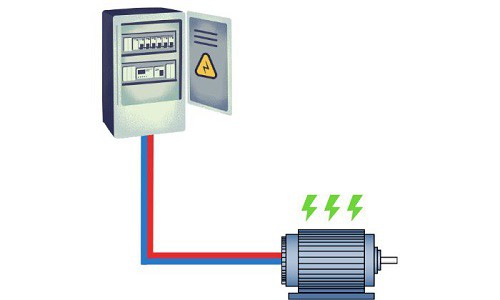If you’re an electrical enthusiast, you may have encountered the term “Full Load Amps” or “FLA.” But what exactly does it mean, and why is it important in electrical systems?
In this article, we will comprehensively answer your question, “What is full load amps?” Let’s understand its definition, explore its significance in electrical systems, and discuss the amperage calculation methods and factors that affect it below.
Table of Contents
Understanding Full Load Amps
1. Definition and Explanation
Full load amps, or FLA in electrical terms, refers to the maximum current drawn by an electrical device or motor when operating at its full load capacity. The lower the FLA, the more efficient the equipment is.
2. Importance in Electrical Systems
Understanding full load amps is crucial for several reasons. First, it enables engineers and electricians to select the proper electrical components and protection devices to ensure the motor’s safe and efficient operation, such as fuses and circuit breakers.
Second, full load amps play a significant role in equipment maintenance. Regular FLA monitoring helps identify deviations from normal operating conditions, indicating potential issues with the device or motor.
This proactive approach ensures timely maintenance or repairs, preventing costly breakdowns and downtime.
3. Calculating Full Load Amps
Calculating full load amps involves considering several crucial factors, including the power rating, voltage supply, efficiency, and power factor. You can determine the FLA required for the electrical system through precise calculation methods.
Let’s explore how the full load amps calculator works with some examples:
- For a Single-Phase Circuit, the formula is:
\[
\frac{{\text{kW} \times 1000}}{{V \times \text{PF} \times \eta}}
\]
Suppose you have a 220V 5 kW motor with a power factor (PF) of 0.8 and an efficiency rating (η) of 88%. The calculation will be:
\[
\frac{{5 \, \text{kW} \times 1000}}{{220 \, \text{V} \times 0.8 \times 0.88}} = 32.28 \, \text{amps}
\]
This means the 5-kW motor has a full load amp rating of 32.28 in a single-phase system.
- For a Three-Phase System, the formula is:
\[
\frac{{\text{kW} \times 1000}}{{V \times \text{PF} \times \eta \times \sqrt{3}}}
\]
Let’s consider a 240V 5 kW motor with a power factor (PF) of 0.8 and an efficiency rating (η) of 88%. The calculation will be:
\[
\frac{{5 \, \text{kW} \times 1000}}{{240 \, \text{V} \times 0.8 \times 0.88 \times 1.73}} = 17.1 \, \text{amps}
\]
This also means that the 5-kW motor has an FLA rating of 17.1 amps in a three-phase system.
If you need information on other full load amps values, refer to the single-phase and 3 phase amps chart for motors with a power factor of 0.8 and an efficiency rating of 0.88 below. This will help you select and design electrical systems to ensure efficient and safe operation.
| Power Rating | Estimated FLA (Single-Phase System) | |||
| Hp Rating | Kilowatts (kW) | 110V | 220V | 240V |
| 0.5 | 0.37 | 4.8 amps | 2.39 amps | 2.19 amps |
| 1 | 0.75 | 9.7 amps | 4.84 amps | 4.44 amps |
| 2 | 1.49 | 19.2 amps | 9.62 amps | 8.82 amps |
| 3 | 2.24 | 28.9 amps | 14.46 amps | 13.26 amps |
| 5 | 3.73 | 48.2 amps | 24.08 amps | 22.1 amps |
| Power Rating | Estimated FLA (Three-Phase System) | |||
| Hp Rating | Kilowatts (kW) | 230V | 460V | 575V |
| 0.5 | 0.37 | 1.32 amps | 0.66 amps | 0.53 amps |
| 1 | 0.75 | 2.68 amps | 1.34 amps | 1.10 amps |
| 2 | 1.49 | 5.32 amps | 2.66 amps | 2.13 amps |
| 3 | 2.24 | 8 amps | 4 amps | 3.20 amps |
| 5 | 3.73 | 13.31 amps | 6.66 amps | 5.33 amps |
| 7 | 5.22 | 18.63 amps | 9.32 amps | 7.45 amps |
| 10 | 7.46 | 26.63 amps | 13.32 amps | 10.65 amps |
| 15 | 11.19 | 39.95 amps | 19.97 amps | 15.98 amps |
Factors Affecting Full Load Amps
Various factors can influence the Full Load Amperage (FLA) of electrical devices and motors. These factors include:
- Voltage Rating: The voltage level supplied to the electrical device or motor directly affects its full load a Higher voltage ratings result in lower current draws, while lower voltage ratings lead to increased amp draws.
- Power Rating (kW or Hp): The power rating, expressed in kilowatts (kW) or horsepower (Hp), is another influential factor in determining FLA. Motors with higher power ratings typically require higher amp draws to function optimally under full load conditions.
- Power Factor: The power factor indicates the motor’s efficiency in converting electrical power into useful work. Motors with low power factors draw higher currents, increasing full load a
- Efficiency Rating: The efficiency rating refers to the ratio of useful mechanical output power to the total electrical input power. Highly efficient motors convert more electrical power into mechanical work, leading to lower full load a
Conclusion
Understanding what is full load amps is essential for making informed decisions when selecting and designing motorized equipment circuits. It ensures safe and efficient electrical system operations.
Additionally, optimizing FLA can improve energy efficiency and cost savings, benefiting businesses and the environment.
However, aside from this current, considering the SF amps, which indicate a motor’s ability to handle temporary overloads without damage, is also essential. For optimal efficiency, seek a motor with a lower FLA and higher SF.

I am Edwin Jones, in charge of designing content for Galvinpower. I aspire to use my experiences in marketing to create reliable and necessary information to help our readers. It has been fun to work with Andrew and apply his incredible knowledge to our content.



